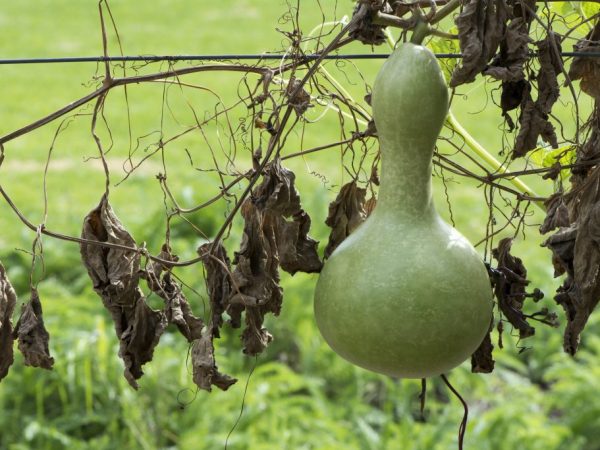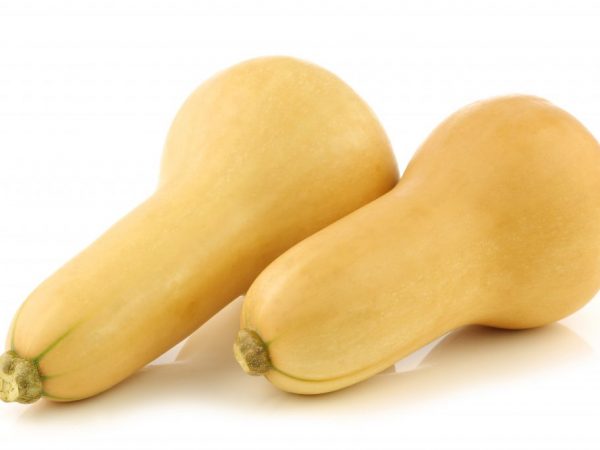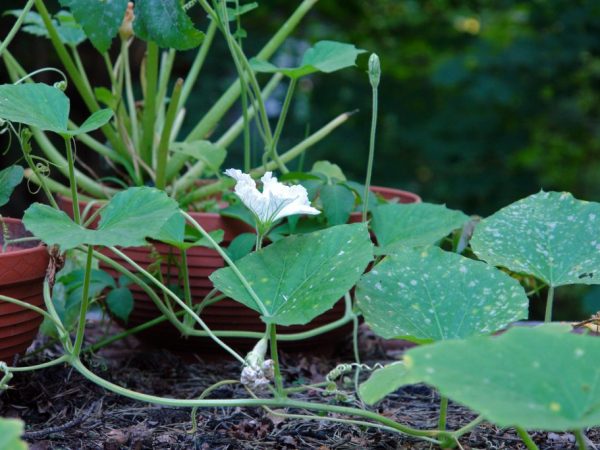Calabash
Bottle gourd, or gourd, is a material for creating decorative objects. Crafts and dishes are made from it.

Calabash
Botanical characteristic
Bottle gourd is a vegetable with large fruits that have an elongated rounded shape, often pear-shaped, sometimes oval. Some specimens have a length of up to 2 m, a diameter of 10 cm or more. The bark is dense, waterproof, has a green color, similar to the shade of a watermelon.
The scientific name for an ornamental vegetable, shaped like an hourglass, is lagenaria.
The stem of the plant is liana-shaped, faceted, the lianas are covered with fluff. Each vine reaches a length of 15 m or more. On each bush, 10-15 vegetables are formed with a mass of 0.5-1.5 kg. Adjusting the size of vegetables is obtained by pinching the lateral shoots and removing excess ovaries during the flowering stage.
The root system is well developed. The main root goes 0.7-0.8 m in depth, the lateral roots - 2.5-2.8 m. Lagenaria is able to form roots above the ground.
Vegetable growers take strong roots for rootstocks. They are used to inoculate melons and watermelons, which increases their productivity and accelerates the development process.
The foliage has a pentagon shape and a corrugated surface. Flowering occurs in small white inflorescences, which can be seen in the leaf axils open only at night.
Practical use
Bottle gourd does not have a characteristic sweet taste, is bitter and can be completely inedible. Bitter young vegetables have a loose structure, they are eaten until the diameter of the vegetable reaches 20-40 cm. The pulp of young gourd is beneficial and has a flavor inherent in ordinary pumpkin.
The main application of the decorative bottle lagenaria is interior design. When ripe under a crust that hardens to a tree-like state, the pumpkin pulp dries up. The process of numbing the bark is provided by stony cells - sclereids, which make it especially hard. Such properties of the bark make it possible to use it in the manufacture of interior decorations and household items: dishes, smoking pipes, toys, musical instruments. Baskets and straw hats are woven from pumpkin stalks.
Drying and processing
To use a gourd for decorative purposes, it needs to be cleaned and dried. First, it is dipped in water so that it is completely wet, and covered with a damp cloth. The duration of the soaking process depends on the thickness of the bark and is equal to 0.5-1 hours.
During the soaking process, the vegetable is regularly turned over to ensure that it gets evenly wet.
The readiness of the vegetable for processing is checked by removing the top plaque. To do this, use a simple household metal mesh for washing dishes. When cleaning the wax layer, they try not to apply special efforts so as not to harm the surface of the vegetable.

They make beautiful bottles of fruits
From the gourd, they make beautiful bottles for supplying liquids, as well as containers for storing cereals. In this case, the liquid should not be stored in a bottle pumpkin for more than 2 days. Do not pour hot drinks into the pumpkin mold.
To peel a vegetable from the inside, you need to do the following:
- a place for a hole with a diameter of a plug is marked on the neck;
- small-diameter holes are drilled around the tail, through the joints of which a pumpkin tail is cut with a scalpel or a construction knife;
- the resulting hole is cleaned with fine sandpaper, having previously rolled it up with a funnel;
- using a metal rod, clean the insides of the vegetable;
- the remains of fibers and seeds are taken out with a wire hook.
The cleaned form is poured with water, placed in a warm place and waited for the beginning of fermentation of the liquid. This process usually takes 3-5 days. At the same time, make sure that the water fills the pumpkin to the very brim. Fermentation signs:
- mold appears on the vegetable;
- the liquid inside begins to bubble.
The rest of the water together with the swollen pulp is drained, the mold is covered with sharp pebbles and poured with a small amount of water, shaken for 5-10 minutes, then everything is drained. This procedure is repeated until clear water mixed with stones pours out of the container, without residues of pulp and seeds.
To dry the peeled vegetable, it is turned upside down and dried in a warm place, while the neck should not be in close contact with the surface; air must enter the vessel.
Growing features
Lagenaria grows mainly in tropical regions, but it is grown in the Russian climate. Cultivation of bottle gourds is carried out mainly by the seedling method.
Seed preparation and seedling growing
Bottle pumpkin seeds, prepared for planting, are pre-soaked and germinated in pot containers. Taking into account the increased density of the seed coat, the duration of soaking the seeds in the dish pumpkin is increased to 2 days. The water temperature reaches 30-35 ° С. The soaking procedure can be avoided by cutting off the top of the seeds before planting.
The prepared seeds are placed in a substrate 3-4 cm and covered with a film on top to create a greenhouse effect and accelerate germination. A mixture of turf (2 parts), humus (1 part) and sand (1 part), to which wood ash, coal or superphosphate is mixed, is suitable as a substrate. After 25-30 days, the germinated shoots are ready for transplanting into soil.
Seat selection and landing
The most suitable place to plant a pumpkin is on a land well-lit by sunlight, protected from direct winds. Often it is planted near the walls of buildings, on the south side of the fences. The best time to plant bottle gourds is early summer.

The plant needs support
Soil requirements:
- looseness;
- neutral or slightly alkaline reaction;
- lack of stagnant moisture;
- lack of groundwater.
The bottle gourd is planted at a distance of 1 m. As the plants grow, they create trellis supports. In regions with low temperatures, the gourd is grown in closed, heated greenhouses.
Further care
Bottle gourd grows quickly with proper care, which includes regular watering, fertilizing, and pollination. Watering is carried out as the soil dries up. Bottle lagenaria, demanding of fertile soil, needs organic and mineral fertilizing, which it is provided with every 10 days.
It will be possible to get fruits from a bottle variety only with artificial pollination, which is carried out at night when the inflorescences open. Pollination is carried out at the initial stage of flowering. This requires collecting pollen from three male plants.
Harvest time
The harvest time depends on what the vegetable was planted for:
- for consumption, the crop of lagenarii is harvested after 3 months from the moment of planting the seedlings;
- for decorative purposes, vegetables are left on the bush for 4 months. The deadline for collection is before the onset of cold weather.
The seeds obtained from vegetables are used for subsequent plantings.
Advantages and disadvantages of the variety
The dish pumpkin has the following advantages:
- resistance to a number of diseases (mosaic, powdery mildew, anthracnose, etc.);
- the possibility of using for food and decorative purposes;
- beautiful external decorative appearance of the vine that decorates the site.
Gardeners note the following disadvantages of bottle gourd:
- exactingness to soil fertility;
- low resistance to low temperatures;
- the need for artificial pollination.
Conclusion
Lagenaria pumpkin is a tropical pumpkin known for its unusual pear-shaped or oval-shaped fruits, which are used mainly for decorative purposes, because the pulp of ripe vegetables has a bitter rather than sweet taste. The vegetable is suitable for growing in warm countries, but if certain conditions are met, the vegetable crop is suitable for growing in Russian regions.

